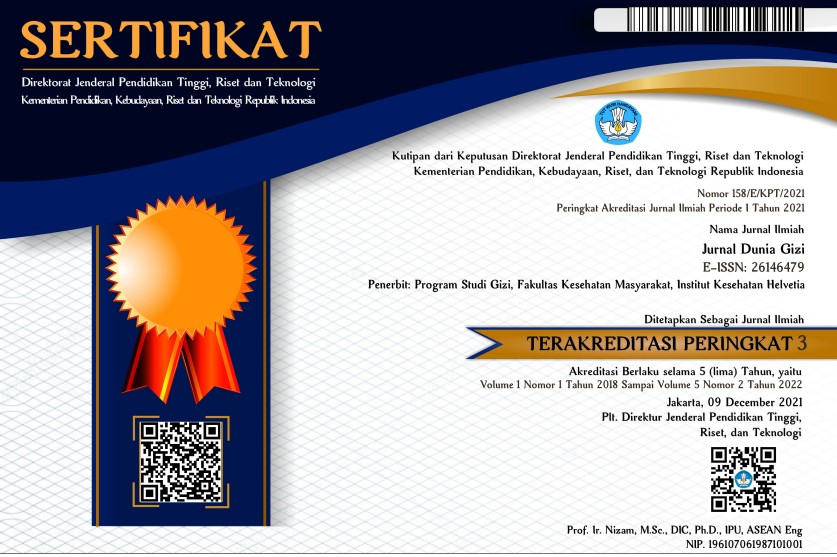Efek Perkecambahan Kedelai (Glycine max) terhadap Mutu Gizi Formula Modisco Gizi Buruk Substitusi Tepung Kecambah Kedelai
Abstract
Pendahuluan; Dampak negatif gizi buruk pada balita berupa penurunan daya tahan tubuh dan peningkatkan risiko kematian. Salah satu upaya penanggulangan gizi buruk dilakukan dengan pemberian formula modisco. Kedelai termasuk bahan pangan lokal yang berpotensi untuk bahan pembuatan modisco melalui proses perkecambahan agar mutu gizinya meningkat. Tujuan; Untuk mengetahui pengaruh penggunaan tepung kecambah kedelai terhadap mutu gizi, fisik, dan organoleptik modisco. Bahan dan Metode; Penelitian diawali dengan pembuatan kecambah kedelai dan dilanjutkan dengan formulasi modisco. Formulasi modisco dilakukan menggunakan rancangan acak lengkap dengan 4 perlakuan berupa proporsi susu bubuk skim dan tepung kecambah, masing-masing sebesar 100:0 (P0), 60:40 (P1), 50:50 (P2), dan 40:60 (P3). Penilaian mutu modisco dilakukan terhadap kandungan gizi, mutu gizi dan sensorik, serta membandingkan dengan standar mutu yang terkait. Hasil; Penggunaan tepung kecambah kedelai meningkatkan densitas kamba (p=0,0001), viskositas (p=0,234), kadar air (p=0,074), protein (p=0,001), lemak (p=0,0001), dan kepadatan energi (p=0,0001). Namun penggunaan tepung kecambah kedelai menurunkan daya larut air (p=0,0001), kadar karbohidrat (p=0,0001), kadar abu (p=0,0001), dan mutu protein. Hasil uji organoleptik menggunakan uji rangking menunjukkan penilaian tertinggi pada atribut warna, rasa, dan viskositas (kekentalan) adalah perlakuan P2. Penilaian tertinggi pada atribut aroma adalah perlakuan P0. Kesimpulan; Modisco yang memenuhi standar Codex Standard for Follow-up Formula no 156-1987, MP-ASI bubuk instan SNI 01-7111.1-2005, dan standar modicso berdasarkan panduan Kemenkes 2020 dapat dibuat dengan proporsi tepung susu skim dan tepung kecambah kedelai menggunakan rasio 50:50.
Keywords
Full Text:
PDFReferences
Gillani S, Shafiq MN, Bhatti MA, Ahmad TI. Impact of Economic Growth on Child Malnutrition in Pakistan: A Time Series Analysis. iRASD J Econ. 2022;4(1):149–63.
World Bank. Healthy Development [Internet]. The World Bank; 2007. Available from: http://elibrary.worldbank.org/doi/book/10.1596/978-0-8213-7193-0
Kemenkes RI. Hasil Riset Kesehatan Dasar Tahun 2018. Jakarta: Kementrian Kesehatan Republik Indonesia; 2018.
Kemenkes RI. Hasil Riset Kesehatan Dasar Tahun 2013. Jakarta: Kementrian Kesehatan Republik Indonesia; 2013.
UNICEF. Global hunger crisis pushing one child into severe malnutrition every minute in 15 crisis-hit countries. Unicef. 2022;20–3.
WHO. Malnutrition. World Health Organization. Genewa; 2021.
Kemenkes RI. Pedoman Pencegahan Dan Tatalaksana Gizi Buruk Pada Balita. Jakarta: Kementrian Kesehatan Republik Indonesia; 2020.
Qin P, Wang T, Luo Y. A review on plant-based proteins from soybean: Health benefits and soy product development. J Agric Food Res. Elsevier B.V.; 2022 Mar;7:100265.
Winarsi H. Protein Kedelai dan Kecambah Manfaatnya bagi Kesehatan. Yogyakarta: Kanisius; 2010.
Mazumder MAR, Hongsprabhas P. A review on nutrient quality of soymilk powder for malnourished population. Pakistan J Nutr. 2016;15(6):600–6.
Giri SK, Mangaraj S. Processing Influences on Composition and Quality Attributes of Soymilk and its Powder. Food Eng Rev. 2012;4(3):149–64.
Asrat U. Promoting Home Prepared Soy-dishes for Fighting Protein-Energy Malnutrition: Evidence from Demonstration Training. Food Sci Qual Manag. 2021;(March):17–23.
Muhimbula HS, Issa-Zacharia A, Kinabo J. Formulation and sensory evaluation of complementary foods from local, cheap and readily available cereals and legumes in Iringa, Tanzania. African J Food Sci. 2011;5(1):26–31.
Onoja U, Akubor P, Gernar D, Chinmma C. Evaluation of Complementary Food Formulated from Local Staples and Fortified with Calcium, Iron and Zinc. J Nutr Food Sci. 2014;4(6):1–6.
Astawan M, Wresdiyati T, Ichsan M. Physichochemical Characteristics of Germinated Soybean Tempe Flour. J Pangan dan Gizi. 2016;11(1):35–42.
R MT. Petunjuk Laboratorium Ilmu Pengetahuan Bahan Pangan. Bogor: PAU pangan dan gizi IPB; 1992.
AOAC. Official method of Analysis. 18th Edition, Association of Officiating Analytical Chemists. Washington DC, Method 935.14 and 992.24; 2005.
Subramanian S, Viswanathan R. Bulk density and friction coefficients of selected minor millet grains and flours. J Food Eng. 2007;81(1):118–26.
Elkhalifa AEO, Bernhardt R. Combination Effect of Germination and Fermentation on Functional Properties of Sorghum Flour. Curr J Appl Sci Technol. 2018;30(1):1–12.
Abdurrasyid Z, Astawan M, Wresdiyati T, Nurtama B. Mutu Fisikokimia dan Sensori Minuman Serbuk Tempe. Pangan. 2021;30(2):117–28.
Adedeji OE, Ajayi OA, Orafa NP, Ishaya G. Effect of Processing on the Functional and Pasting Properties of Complementary Foods Prepared From Sorghum, Soybean and Roselle Calyces Flour Blends. FUW Trends Sci Technol Journal, www.ftstjournal.com e-ISSN. 2018;1(2):391–4.
Almeida MB de M, Gomes Júnior SC, Silva JB da, Silva DA da, Moreira MEL. Study on viscosity modification of human and formula milk for infants with dysphagia. Rev CEFAC. 2017;19(5):683–9.
Alamu EO, Therese G, Mdziniso P, Bussie MD. Assessment of nutritional characteristics of products developed using soybean (Glycine max (L.) Merr.) pipeline and improved varieties. Cogent Food Agric. Cogent; 2017;3(1).
Sakare P, Jadhav ML, John H. Study on Physical Properties of Soaked Soybean and Functional Properties of Germinated Soy flour. J Inst Eng Ser A. Springer India; 2020;101(4):787–94.
Asiah N, Cempaka L, David W. Pendugaan Umur Simpan Produk Pangan. UB Press. 2018. 1-133 p.
Annan R.A., Webb P. BR. Management of Moderate Acute Malnutrition ( MAM ): Current Knowledge and Practice. 2014;(September):37.
Elkhalifa AEO, Bernhardt R. Influence of grain germination on functional properties of sorghum flour. Food Chem. Elsevier Ltd; 2010;121(2):387–92.
Ghani M, Kulkarni KP, Song JT, Shannon JG, Lee J-D. Soybean Sprouts: A Review of Nutrient Composition, Health Benefits and Genetic Variation. Plant Breed Biotechnol. 2016;4(4):398–412.
Golden MH. Proposed Recommended Nutrient densities for moderately malnourished children. Food Nutr Bull. 2009;30(3 SUPPL. 1).
Dipasquale V, Cucinotta U, Romano C. Acute malnutrition in children : Pathopysiology, Clinical Effects and Treatment. Nutrients. 2020;12(2413).
Burssens S, Pertry I, Diasolua D, Kuo Y-H, Van M, Lambei F. Soya, Human Nutrition and Health. Soybean Nutr. 2011;(February).
FAO/WHO. Energy and protein requirements. Vol. 27, World Health Organization Chronicle. 1985. p. 481–6.
Wahono T. Dasar-dasar Uji Indrawi. Malang: Jurusan Teknologi Hasil Pertanian UB; 2006.
Murugkar DA. Effect of sprouting of soybean on the chemical composition and quality of soymilk and tofu. J Food Sci Technol. 2014;51(5):915–21.
DOI: https://doi.org/10.33085/jdg.v5i2.5484
Refbacks
- There are currently no refbacks.

This work is licensed under a Creative Commons Attribution-NonCommercial 4.0 International License.









1.png)







.png)










